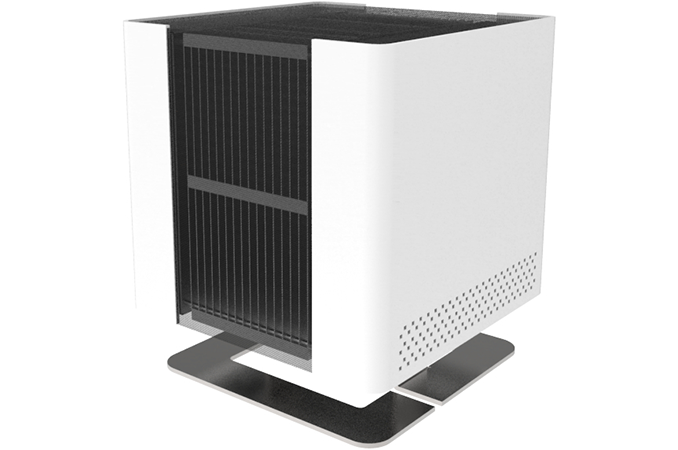Calyos NSG Cube: Passively Cooled SFF PC with Intel Core and GeForce GTX 1060
by Anton Shilov on December 20, 2016 4:00 PM EST
Calyos plans to display its first passively cooled small form-factor gaming PC at CES early next month. The NSG Cube promises to pack an Intel Core processor as well as a GeForce GTX 1060 graphics card to offer a decent level of performance in games by a system that produces absolutely no noise.
Apart from performance, a lot of gamers nowadays demand computers in compact form-factors and even more people want their systems to be quiet. Developers of key components of PCs understand their customers, which is why companies like AMD, Intel, NVIDIA introduced very power-efficient CPU and GPU architectures as well as SFF designs in the recent years. Meanwhile, it is hard to wed a small form-factor with passive cooling: the former needs airflow and the latter needs either large radiators or liquid cooling (which means large radiators in the end). Apparently, this is exactly what Calyos is trying to do with its NSG Cube.
| Calyos NSG Cube at Glance | ||||
| Component | TDP | |||
| CPU | Intel Core in LGA1151 form-factor | 35 W (?) | ||
| PCH | Intel Z170 | 6 W | ||
| Motherboard | ASUS Z170I Pro Gaming | Over 6 W | ||
| GPU | ZOTAC GeForce GTX 1060 Mini-ITX | 120 W | ||
| Other | DRAM, SSD/HDD | 39 W | ||
| Total TDP | - | ~200 W | ||
At present, the amount of information that we have in hand (thanks to FanlessTech) is scarce. What we do know is that the system is based on the ASUS Z170I Pro Gaming motherboard in a Mini-ITX form-factor and uses the ZOTAC GeForce GTX 1060 Mini-ITX graphics adapter. The passively cooled SFF PC will have TDP of 200 W, which is not a lot and given the fact that the video card has TDP of 120 W, this leaves 80 W for the CPU (no overclocking here), PCH, DRAM, SSD and so on. The NSG Cube is designed to be small but uses aluminum radiators to cool down its components. At this point Calyos has not stated if the power supply is internal or external - given the use of the ASUS motherboard, we would suspect an internal unit, either SFX or proprietary.
Calyos will demonstrate its NGS Cube at CES in early January. Pricing and ETA of the system are unclear at this point, but the PC will be available commercially.
Related Reading:
Source: FanlessTech
















21 Comments
View All Comments
guidryp - Friday, December 23, 2016 - link
I watched a video review. All 4 sides are identical.I just don't think there is any way to route heat-pipes to the other two.
Gadgety - Wednesday, December 21, 2016 - link
Yes it will accumulate dust. I prefer the looks of the DB4, but if the Calyos can handle both CPU and GPU passively it's still interesting.DanNeely - Tuesday, December 20, 2016 - link
They could combine a picoPSU (or equivalent) and an external brick to keep the PSU outside the case while still using a conventional mobo.jtd871 - Tuesday, December 20, 2016 - link
There are a few people working on perfecting this kind of setup with the indie NFC S4 mini case. HDPlex is rumored to be close to releasing a new ~200W PSU to make this happen. I'd still want to have at least one fan (spinning slowly) to force airflow past the heatsink(s).fanlessguy - Wednesday, December 21, 2016 - link
more like a copy of the Streacom DB4 one http://www.streacom.com/products/db4-fanless-chass...Meteor2 - Wednesday, December 21, 2016 - link
I'll be amazed if either of these can dump 200W in a 21 Celsius room. And you can forget about summertime...MrSpadge - Thursday, December 22, 2016 - link
Summer: that's only about 10°C warmer than the 21°C it should definitely work at. If they achieve ~80°C CPU / GPU temperature at 21°C, they'd still be fine during summer in most environments. IF temperatures rise, CPU and GPU can gracefully limit their turbo states and run more energy efficiently, dropping power consumtpion and heat generation.BrokenCrayons - Thursday, December 22, 2016 - link
Passive cooling is nice and all that, but I'm not sure how much value is truly added to a computing experience by eliminating all of the cooling fans when most fans aren't really very noisy to begin with.zodiacfml - Friday, December 23, 2016 - link
Thinking the same thing. Why waste money and get more weight if a large, slow moving fan will work multiple times better?guidryp - Friday, December 23, 2016 - link
For me fans create noise, suck in dust (even on supposedly filtered cases), and are a point of failure.I have replaced three failing case fans, and the CPU fan in my system and even though it draws air through two filtered fans, my CPU heatsink had packed in dust.
My GPU fan started failing but I manged to cram some oil in that one to keep it going.
Noise/Dust/Failures.
I would love an essentially closed passive system like the DB4. No noise, no dust and no fans to fail. But I probably have to wait for a good IGP solution.
Maybe the ZEN IGPs will be good enough for my needs.